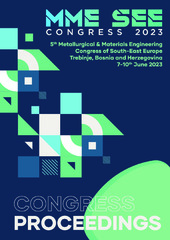Приказ основних података о документу
Principal Component Analysis of Morphological Descriptors for Assessment of Surface Defects Induced by Extreme Conditions
| dc.creator | Martinović, Sanja | |
| dc.creator | Alil, Ana | |
| dc.creator | Savić, Aleksandar R. | |
| dc.creator | Glišić, Dragomir | |
| dc.creator | Živojinović, Dragana | |
| dc.creator | Volkov Husovic, Tatjana | |
| dc.date.accessioned | 2023-11-24T14:06:24Z | |
| dc.date.available | 2023-11-24T14:06:24Z | |
| dc.date.issued | 2023 | |
| dc.identifier.isbn | 978-86-87183-32-2 | |
| dc.identifier.uri | https://grafar.grf.bg.ac.rs/handle/123456789/3280 | |
| dc.description.abstract | Implementation of statistical analysis for monitoring the formation and propagation of defects that occurred due to exposure of the material to thermal shock and cavitation is presented in this study. Results of two groups of materials are shown: refractory concrete sintered at three temperatures and ceramic materials based on cordierite and zircon. Alumina- based refractory concretes were subjected to thermal stability test, while the surface morphological changes regarding the defects were monitored after a certain number of thermal shock cycles. Cordierite and zircon based materials were initially subjected to cavitation testing while after specified time periods, morphological changes in the surface defects were analyzed. Besides the standardized methods, non-destructive testing of materials was applied for monitoring the surface changes. Cameras, microscopes, and numerous software enable recording images of sample surface with appropriate magnifications as well as monitoring and quantifying the surface damage degree with various image analysis tools. Thus, this approach offers the quantification of selected morphological descriptors regarding the defects. Obtained values were then subjected to pattern recognition method, the principal component analysis that can provide information on extracted morphological descriptors by describing the main difference among observed defects and identifying variations among them. As a result, a better insight into surface degradation that occurs during exposure to extreme conditions was obtained. The multivariate analysis provided grouping and thus reduction of the descriptors while maintaining the highest percentage of variance unchangeable. More precisely, the analysis extracted the most informative descriptors that should be observed for monitoring changes in surface defects and determining a degradation mechanism. | sr |
| dc.language.iso | en | sr |
| dc.publisher | Association of Metallurgical Engineers of Serbia (AMES), Kneza Miloša 9/IV, 11000 Belgrade, Serbia | sr |
| dc.relation | info:eu-repo/grantAgreement/MESTD/inst-2020/200135/RS// | sr |
| dc.rights | openAccess | sr |
| dc.rights.uri | https://creativecommons.org/licenses/by-nc-nd/4.0/ | |
| dc.source | Congress proceedings - MME SEE 2023 5th Metallurgical & Materials Engineering Congress of South-East Europe | sr |
| dc.subject | Thermal shock | sr |
| dc.subject | Cavitation erosion | sr |
| dc.subject | Surface defects | sr |
| dc.subject | Morphological descriptors | sr |
| dc.subject | Principal component analysis (PCA) | sr |
| dc.title | Principal Component Analysis of Morphological Descriptors for Assessment of Surface Defects Induced by Extreme Conditions | sr |
| dc.type | conferenceObject | sr |
| dc.rights.license | BY-NC-ND | sr |
| dc.citation.epage | 170 | |
| dc.citation.spage | 164 | |
| dc.identifier.fulltext | http://grafar.grf.bg.ac.rs/bitstream/id/12331/MMESEE-2023-RADSM.pdf | |
| dc.identifier.rcub | https://hdl.handle.net/21.15107/rcub_grafar_3280 | |
| dc.type.version | publishedVersion | sr |

